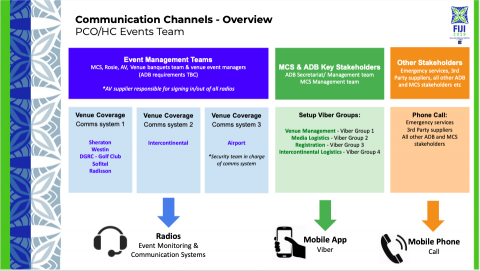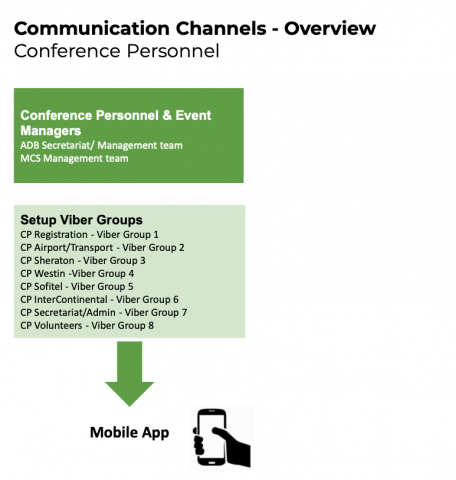11.3. Telecommunications
Voice Communications
- To facilitate communication at the meeting site among members of the ADB and the Host Country Secretariats, mobile communication facilities and equipment, such as cell phones and frequency radios, are required. The host country provides, free of charge, 250 cell phones and 3 wireless desk phones for ADB personnel. Each phone has a battery, charger, loaded with credit for the duration of the Annual Meeting and is capable of providing internet access through tethering (with the exception of the wireless desk phones). International direct dial (IDD) facilities are required for 45 cell phones and the 3 wireless phones, while other phones are allowed to make local calls only. It is also expected that if a PCO is appointed to manage the annual meeting, that they too are provided with a wireless two way comms system with their own dedicated channel. This ensures they are contactable at all times by both the host country and the ADB and provides a backup for if mobile reception fails.
- Cellular calls, Short Message Service (SMS), data and IDD services can be provided to all ADB devices in a pooled manner. The recommended allowable is as follows:
Local Call Minutes (within calling circle) Unlimited Local Call Minutes (outside of calling circle) 50,000 minutes SMS Messages Unlimited Local Cellular Data 2.5 Terabytes IDD Call Minutes 5,000 minutes - To minimize queries on how to operate telephones, cell phones, and other equipment, instructions on how to operate the equipment, as well as contact information for the cellular service providers are sent to ADB in advance.
- ADB provides the list of personnel requiring cellular phones. Service providers need to compile a phone directory based on this list and ADB’s requirement to include / exclude specific numbers. The directory should then be pre-load into the phones prior to distribution. The phones should be handed over to ADB OSEC advance team as they arrive at the Annual Meeting venue for distribution and will be collected from the OSEC team after the Annual Meeting.
Sample communication routing diagram:


